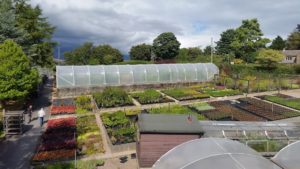Warner Edwards
 Early this year, Waterseekers was contacted by a very well know distillery in Northamptonshire. They wanted to look at abstracting water to use in the distilling process. The client had already had a prognosis report commissioned by the British Geological Survey and the outlook was not very good, with a 90% chance of hitting a dry hole.
Early this year, Waterseekers was contacted by a very well know distillery in Northamptonshire. They wanted to look at abstracting water to use in the distilling process. The client had already had a prognosis report commissioned by the British Geological Survey and the outlook was not very good, with a 90% chance of hitting a dry hole.
Tyntesfield House – National Trust, Bristol
 Two water boreholes were drilled to a depth of 150m in the grounds of this spectacular Victorian Gothic Revival house and estate near Wraxall. As a result of the boreholes, the National Trust will be revitalising a Victorian boating lake and supplying water to irrigate the house gardens.
Two water boreholes were drilled to a depth of 150m in the grounds of this spectacular Victorian Gothic Revival house and estate near Wraxall. As a result of the boreholes, the National Trust will be revitalising a Victorian boating lake and supplying water to irrigate the house gardens.
Welcome to the Victorian world of Antony Gibbs. An ordinary man with an extraordinary fortune, a man of vast riches but simple pleasures. Antony was the second generation of the Gibbs family to live at Tyntesfield. He epitomised the Victorian age, fascinated by art, technology and travel. We like to think he would be proud of the technology we have used to install Tyntesfield House with its own water supply from two water boreholes, which will keep a boating lake topped up and many acres of gardens watered.
One of the main objectives of the project was to provide enough water from the boreholes to rejuvenate the boating lake. This will attract more wild life and provide great pleasure for visitors who wish to picnic or take to the awes of a boat.
[Not a valid template]David Ross Nurseries – Kettlehulme, Cheshire.
 Waterseekers was called to look at an existing borehole a Nursery that was causing problems due to the high level of iron in the water. The existing borehole was drilled in 1999 and from day one Iron removal system/filters were in place. The levels of iron made it very difficult to filter out and over time the maintenance on the system became a daily process that was taking up too much of their daily routine.
Waterseekers was called to look at an existing borehole a Nursery that was causing problems due to the high level of iron in the water. The existing borehole was drilled in 1999 and from day one Iron removal system/filters were in place. The levels of iron made it very difficult to filter out and over time the maintenance on the system became a daily process that was taking up too much of their daily routine.
We inspected the borehole with a down-the-hole camera to establish the construction of the borehole. It became apparent very quickly that the construction was the cause off the issue but unfortunately we couldn’t do much with the existing borehole.
It was agreed to construct a new borehole at the opposite end of the site, where construction commenced. The goal was to seal off the top 33m of shale into the competent millstone grit. The previous borehole had 4m of steel in the borehole and was not cemented in place. 33m of 219 millimetres 8 millimetres wall steel was installed and the annulus between the steel and the strata was cemented in place. We then open holed the borehole to a depth of 96m, maintaining a good conductivity in the water, coal was encountered at 93 meters and the conductivity of the water increased indicating higher levels of possible elements/metals in the water. At this point we ceased drilling and installed a tremmie pipe and cemented the borehole from 96m to 90m to stop contamination from the coal band.
The borehole proved very successful with no iron present. In fact, no metals at all! The water was deemed drinkable by the laboratory that carried out the testing and the client is very pleased with the outcome. Waterseekers decommissioned the old system including decommissioning off the old borehole.
Finally, and on completion of the new borehole Waterseekers installed pre-insulated suitable storage tank, and a GRP plant-room with a variable drive booster set, sized to maintain the correct volume and pressures around the nursery.
[Not a valid template]Sheffield United FC
 Sheffield United Football Pitch – Bramall Lane, Spring 2015 Commercial Water Well Installation Sheffield United Football Club – Bramall Lane, Spring 2015.
Sheffield United Football Pitch – Bramall Lane, Spring 2015 Commercial Water Well Installation Sheffield United Football Club – Bramall Lane, Spring 2015.









